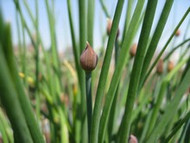How To Grow Chives
A member of the onion family, chives are well worth cultivating in the vegetable and flower garden. They take up very little space, and the whole plant can be eaten from top to bottom - the bulbs as mild onions, the leaves in salads and flavouring, the flower heads as a splash of colour to salads.
Varieties of Chive
There are two main types of chive, common and Chinese or garlic (allium tuberosum), both are cultivated in exactly the same way, although Chinese chive grow slower. Chinese chives have an added subtle garlic flavour to them and they are commonly used in Chinese cooking.
There are several new varieties of chives available from specialist seed merchants and they aim to provide plants which produce very fine leaves, much preferred by cooks. We have tried some of these and they do indeed produce finer leaves, but only in the first year. The seeds are cheap, so try a few varieties, but we do recommend the common chive for most purposes.
Site and Soil
Most soils, partial shade or full sun.
Plant to Harvest Time
3 months
Where To Grow
Chives will grow in almost all soils, the ideal one being well-dug with the addition of well-rotted compost or organic material. Work in a handful or two of bonemeal per square metre (yard). Chives are not greedy feeders, so it is not necessary to feed throughout the year if the soil has been prepared as described.
Full sun or partial shade suit them equally well, and although they are fairly tolerant of drought, don't plant them in very dry places.
Propagation
Chives are very similar to onions, they have a bulbous root and green leaves. The bulbs multiply quickly over a few years and this provides the easiest method of propagation. Simply dig up the clump of bulbs in March or October, carefully separate them into individual bulbs and replant with the tips of the bulbs level with the soil surface. They thrive on this method of propagation, because it relieves the congestion in the bulbs.
Growing chives from seed is almost as easy - sow the seeds indoors using normal potting compost in March time (or directly outside in April) . Make sure the compost remains moist. The seedlings will appear a week to ten days later. Transfer them outside a month after sowing with 10cm (8in) between each plant.
Plant Care
This is simple! If the soil has been prepared as described above, just sit back and watch them grow! They are almost completely free of disease, and their only requirement is watering if the conditions become very dry. They occasionally suffer from onion fly, but this is almost always because they have been planted near onions which have been attacked - the solution is not to plant chives near onions.
Chives are perennial evergreen plants, and keep their leaves in most winters. In colder winters, the leaves may die back completely, but don't despair - their roots are still alive and they will begin new growth next spring.
Harvesting
Cut the chive leaves with scissors when required, starting with the outside leaves (those nearest the edge of the pot) and working your way inwards. Always leave 5cm (2in) of leaves remaining. The leaves rapidly grow back and can be cut several times in the growing season. Plants grown from seed should be left alone (although remove the emerging flower heads) until July in the first year to allow a good root system to establish itself.
Chives produce a mass of purple flowers in late Spring, and a second flush may well occur between June to July . If you are growing the plants for eating only, these flowers should be removed as soon as possible - if left, they restrict the growth of new leaves. If the flowers are required for eating or for their colour, it is best to keep separately a couple of chive plants for this purpose. When the flowers are starting to fade, cut the whole plant to 5cm (2in) from ground level and you will then have a second set of leaves produced and probably a second flush of flowers.
The bulbs of chives are edible as mild onions, although we don't really recommend this. The flowers are definitely edible and are great added to salads - their colour makes salads come alive. The flower heads are actually a mass of smaller flowers, which should be separated before adding to the salad. The stalk is also edible, but is tasteless and very very tough - throw it away!
Container Growing
This herb is ideally suited to container culture and will grow happily in potting compost. Attention throughout the year is minimal. Water if the compost is drying out, and feed with liquid plant food monthly throughout the growing season.
Container grown plants are more likely to affected by severe frosts, so move the containers close to the house walls in winter.
Chives In Cooking
Chives should be used fresh and uncooked, otherwise they loose almost all their flavour. When used with cooked foods, add them after cooking. They can be dried, but their is little point because they then have no flavour. One way to store them is to chop the leaves into 1cm (half inch) lengths and place them in ice cue containers with some water. Freeze them, and then defrost an ice cube or two when need to use them.
Chives can be used to add flavour to a huge range of food, probably best known for adding to baked potatoes with butter. Other uses foods it goes well with include mixed vegetables, egg dishes, salads and dressings, broiled poultry, stews, casseroles and baked fish.

